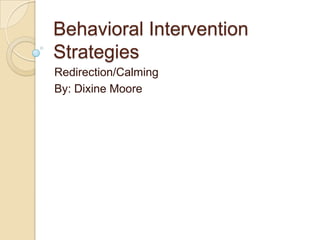
Behavioral intervention strategies
- 2. Introduction Successful behavioral interventions require understanding of the basic principles of behavior. • Behavior topography – what it looks like • Behavior function – its effects on the environment
- 3. Behavioral Interventions Advantages Have measurable outcomes. Are not intended to control students, but enable students to exert more control over their own behavior. The interventions are clearly described which allows for clear identification of desired outcome.
- 4. Positive Reinforcement Desired stimuli is presented to person after appropriate behavior is displayed. Increases the appropriate behavior. Decreases the inappropriate behavior.
- 5. Redirection/Calming Watch for signs of student frustration. Use de-escalation strategies to redirect and calm a student. Be involved with students.
- 6. Be Alert to Triggers that Lead to Misbehavior Some students misbehave because they have not been taught how to behave, which results in • Difficulty developing friendships • Meeting teacher expectations • Dealing with social problems appropriately
- 7. Social Skills Instruction Can affect classroom behavioral issues and management practices. Can clarify teacher expectations and help students understand how they should behave. Can improve social interactions and reduce problem behavior. Become “replacement behaviors”. Teach students to make the “right” choices.
- 8. Results of Teaching Social Skills Helps students develop good relationships • With other students • With teachers • With community members outside of school
- 9. Social Skills Instruction Steps Identify social skill needed to replace problem behavior. Model or show the student how to perform the skill. Allow the student to practice using the skill through role-play situations. Reinforce acceptable performance by letting student perform the skill.
- 10. Social Skills Example – “Asking permission to be dismissed” Raise your hand Wait to be recognized Ask permission to be dismissed Wait for an answer Ask questions if you do not understand the answer.
- 11. Teaching students to Use Positive “Self-Talk” Self-instruction ways of talking through problems. Manages anger Replaces negative with positive thoughts. Students recognize triggers that ignite aggression. Helps to avoid conflicts.
- 12. Benefits of Behavior Intervention Strategies Safe environment for all students. Produce positive outcomes in the classroom. Improves the climate of the classroom. Less frustration in the classroom. Promotes learning for all students. Helps build teacher/student relationships.
- 13. References Skinner, B.F. (1968). The technology of teaching (The Century Psychology Series). Englewood Cliffs, NJ: Prentice Hall, Inc. Sprick, R.S. (2006). Discipline in the secondary classroom: A positive approach to behavior management (2nd ed.). Englewood Cliffs, NJ: Prentice Hall. Sprick, R.S., & Garrison, M. (2008). Interventions: Evidence-based behavioral strategies for individual
- 14. References continued Sugai, G., Horner, R. H., Dunlap, G., Hieneman, M., Lewis, T., Nelson, C.M., et al. (2000). Applying positive behavior support and functional behavioral assessment in schools. Journal of Positive Behavioral Interventions, 2, 131- 143. Walker, H.M., (1995). The acting out child: Coping with classroom disruption (2nd ed.). Longmont, CO: Sopris West.
- 15. References concluded Walker, H. M.., & Shinn, M. R. (2002). Structuring school-based interventions to achieve integrated primary, secondary, and tertiary prevention goals for safe and effective schools. In M.R. Shinn, G. Stoner, & H.M. Walker (Eds.), Interventions for academic and behavior problems: Preventive and remedial approaches (p. 1-26). Silver Spring, MD: National Association of School Psychologists. Witt, J.C., Martens, B.K., Elliott, S.N., (1984). Factors affecting teachers’ judgments of the acceptability of behavioral interventions: Time involvement, behavior problem severity, and type of intervention. Behavior Therapy, Volume 15, Issue 2, 204-209.